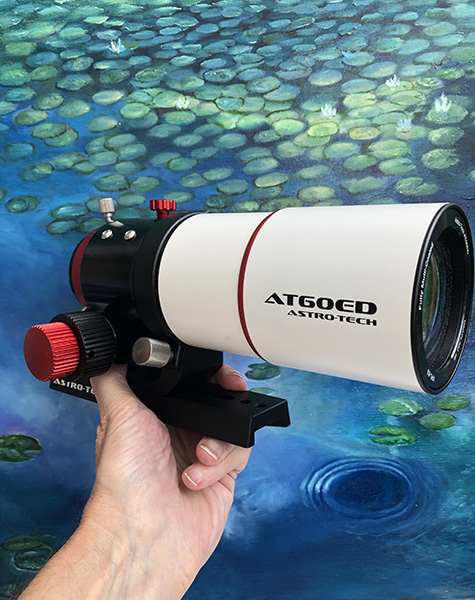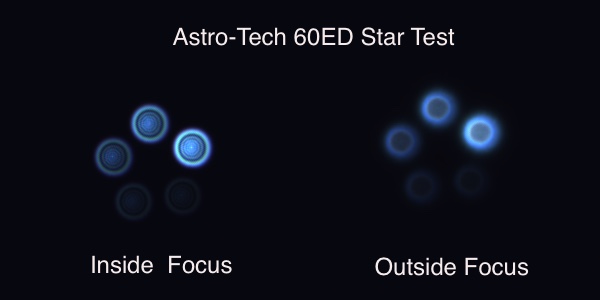Astro-Tech
60ED Review
by Joe Bergeron
by Joe Bergeron
 |
| So very dinky. |
 |
| Ready to go on Celestron AVX mount with
ZWO ASIAir Pro and ASI294 color camera. |
 |
| Star test results using an artificial
star at a distance of 60 feet. |
While languishing through 2020 I conceived a desire to assemble a tiny imaging rig that I could indeed carry aboard a plane, should planes and international travel ever become accessible again. The mount is an iOptron Skyguider Pro, a device which I may someday review separately. But what about the telescope?
Obviously it had to be small, short and light. I quickly settled on one of the 60mm f/6 FPL-53 ED refractors which are sold under many names, including Astro-Tech, William Optics, and Apertura, differing only in the additional bling and branding that’s included. At first I was attracted to the William Optics (I could get one in blue!), but decided I didn’t really need a thermometer in the focuser knob or the other fancy bits provided for a significantly higher price. I chose the Astro-Tech, a brand name of Astronomics in Norman, Oklahoma.
I ordered the scope and some accessories on May 10, 2020, naively hoping I could present it to myself as a birthday gift in June. Well, no. It made its slow way to me in November. Almost everything arrived in the quantities ordered. The telescope itself was clean and pristine, except for a bit of white dust on the objective that came from the felt in the lens cap. It blew right off.
When fully collapsed, the scope looks ridiculously stumpy and cute. It’s a dense little handful, weighing 3.25 pounds according to Astronomics. Mechanically it’s pretty impeccable. The 2” dual speed rack and pinion focuser is solid and precise. It handles my imaging train with no apparent problem. The dedicated field flattener can be unscrewed to reveal internal threads for 2” filters, which took me a while to figure out.
Visually, the scope works like a good but not exceptional 60mm apochromat. It shows no chromatic aberration on anything I point it at. The FPL-53/lanthanum glass combination really, really works! It did a fair job of splitting the Lyra Double-Double, whose separations of 2.6 and 2.3 arc seconds aren’t far from the scope’s theoretical resolution of just under 2 arc seconds. In November it showed some detail on a sharp but tiny Mars at 103x. The Moon always looks fine at this same power, which admittedly isn’t much of a test.
When star testing, at first glance the situation isn’t so pretty. When viewing Arcturus at 103x, I saw a clean Airy disk with two diffraction rings.
Inside focus, the scope exhibits very sharply defined rings with a bright outer ring. Outside…well, essentially a blur. That blur features a brighter blurry ring about halfway between the center and the edge. Sometimes I can see some very faint, ill-defined diffraction rings inside this ring. In an achromat this would indicate significant spherical under-correction. But this isn't an achromat.
A few of you out there are no doubt bursting to tell me to try this with a green filter to eliminate any residual chromatic effects. Well, I did, and it made little difference. So calm down.
I have since learned that what I see is to be expected in an ED doublet scope because of spherochromatism. Therefore my original assessment of the optical quality of my scope was unjustified. What about imaging?
So far I’ve had only a few chances to try serious imaging. In March 2021 I shot the Rosette Nebula. In May I shot the central “Markarian’s Chain” area of the Virgo Galaxy Cluster. Both are good enough to assure me it will do a good job if I ever get it beneath those exotic Southern skies.
The images exhibit a bit of vignetting, with surprised me given my camera’s small Micro 4/3-sized sensor. Flat calibration images help with that. My ASIAir Pro told me the scope’s actual focal length is 373mm, not the advertised 360mm.
Mechanical note: the scope comes with a single mounting ring, with a little shoe that has to be attached to a dovetail bar so you can attach it to a telescope mount. I thought that might not be stable enough for imaging, so I stuck a couple of tube rings onto a Vixen bar. Alas, this did not work. The focuser knobs are so big that they didn’t clear the dovetail cradle on my AVX mount, and even the lock knobs on that cradle got in the way. I had to revert to the original single ring, but that appears to work well enough.
Given the low price of this little telescope, I certainly got what I paid for.
ADDENDUM: February 2022
I've had further chances to work with this telescope. I've used it to image M31, the Pleiades, the Heart Nebula, M33, and the North America nebula, with fine results all around. I'm fully confident in its functionality for imaging.
Optically, recent testing with an artificial star indicates that the collimation is better than I originally thought, or saw. I don't know why it would have changed.
Removing the dew cap, I see the lens cell has four sets of two tiny screws. It seems they affect the alignment of the optical elements relative to one another. It seems wise not to touch them.
Copyright
©2022 by Joe
Bergeron








